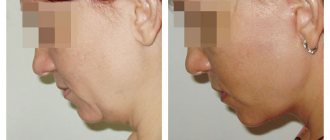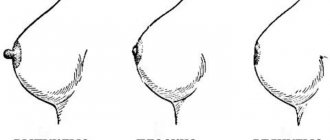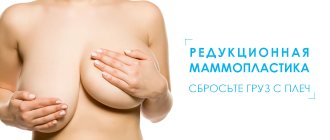Not only the beauty of her breasts, but also her ability to feed a newborn baby will depend on the natural anatomy of a woman’s nipples. Each representative of the fairer sex has a breast that has its own special attractiveness; there are differences not only in size, but also in relation to the shape and color of the nipples. Such differences are normal and should not bother a woman, since such breast characteristics depend on genetics, race, and some other indicators.
Varieties
There are many types of female nipples. There are many reasons for this. Girls have different hormonal levels, the size of the glands, and their shape. According to gynecologists, there are a total of 8 types of female nipples, if we consider only the normal form. It is noteworthy that one person can combine several forms at once.
The first type of female nipples is convex. They protrude beyond the areola. The second type is flat. They are on the same level as the areola. Plump ones are distinguished by the fact that they merge with the areola. If a person is in a calm state, they do not stand out.
The retracted ones do not protrude above the mammary gland at all. The name “versatile” implies that a girl has several types of female nipples - one can be, for example, inverted, and the other can be convex, plump. This is a rare feature, do not worry if it is congenital. But if it appears suddenly during life, this is a reason to contact a specialist as quickly as possible.
There is also a form of female nipple with tubercles. In this case, there are several pimples on the areolas. They are called Montgomery tubercles. At the moment it is unknown why exactly they are needed. Doctors believe that they help keep nipples from drying out.
Beautiful female nipples come with hairs. As a rule, there are very few of them. Some girls remove them with tweezers, but this is a matter of personal preference. Every woman has hair follicles on her chest, but not everyone grows hair there.
Sometimes there are three nipples, but this is already a pathology. As a rule, the third is located on the chest or under it. For some it is invisible and rather resembles a mole, while for others it is completely formed.
Lexical minimum:
- Thorax;
- Compages thoracis;
- Сavitas thoracis;
- Mediastinum;
- Linea mediana anterior;
- Linea sternalis;
- Linea medioclavicularis;
- Linea parasternalis;
- Linea axillaris anterior
- Linea axillaris media
- Linea axillaris posterior
- Linea mediana posterior
- Linea vertebralis
- Linea scapularis
- Linea paravertebralis
- Regio pectoralis
- Regio inframammaria
- Regio scapularis
- Regio infrascapularis
- Regio vertebralis
- Trigonum clavipectorale
- Trigonum pectorale
- Trigonum subpectorale
Unusual shape
Representatives of the fair sex often look for the shape of the nipples of a woman's breast in a photo to make sure that they do not suffer from any pathologies. The variety of shapes determines the presence of nipples that are far from standard, and this is absolutely normal. The unusual shape of this part of the body can become a highlight; this is not always a cause for concern.
Of the unusual shapes, the most common are large nipples, occupying almost the entire chest. They are usually surrounded by an equally large areola. This feature occurs in breasts of any shape, any size. The unusual shape can be teardrop-shaped, extremely convex even in a calm state. As a rule, this form of female nipple occurs on large mammary glands of a specific shape.
It should be borne in mind that if the owner is worried about this, she, if she has the funds, can pay for plastic surgery that will change the shape. As a result, the appearance of the breasts will change.
Causes of pathologies
Inverted nipples are quite common among people, and it is necessary to pay attention to cases where this is not a congenital pathology. As a rule, the shape of the female nipple changes due to injury and mechanical damage. Sometimes this indicates a delay in the development of the body.
Sometimes the change in the shape of the female nipple is affected by wearing uncomfortable underwear on a long-term basis. If the mammary glands function poorly, this also provokes similar pathologies. It is important to regularly compare the normal shape of female nipples (from the photo) and your own breasts, to monitor changes also because their retraction may indicate the development of a cancerous tumor.
Abuse of alcohol, tobacco products, and unfavorable environmental conditions can negatively affect the nipples.
Care and recovery (4 tips)
Caring for the mammary glands and nipples is a whole complex of daily procedures. You just have to develop the habit of spending a little time on them, and the appearance of your bust will certainly delight you with its beauty and elasticity.
Basic care points are:
- Cleansing. It is necessary to use only soft products: it is better to replace soap with a gel with nutritional ingredients, and a scrub with peeling.
- Hydration. To ensure that the skin of the breasts and nipples does not lose moisture and, accordingly, does not lose elasticity, it is important to choose the right creams. They must contain such plant components as aloe, ginseng, horsetail, hops, St. John's wort, and fenugreek. Breast cosmetics containing vitamins A, E, and C, essential oils of muscat rose, lemon and pine have a good tightening effect. It is also worth paying attention to rosehip oil, rich in vitamins and minerals - for many women it becomes a lifesaver during pregnancy and lactation.
- Balanced diet. To produce elastin and collagen, which inhibit ptosis (sagging) of tissues, you need to consume a sufficient amount of protein, amino acids, vegetable fats, and vitamins. Advice: Avoid sudden weight changes. This not only harms the condition of the internal organs, but also significantly affects the condition of the breasts and, accordingly, the nipples.
- Physical exercise. Planks, push-ups, and gymnastics for the pectoral muscles are ideal exercises for toning the chest. It is also worth monitoring correct posture: this reduces the load on the mammary glands and sagging tissue occurs much more slowly.
Diagnostics
Diagnosis will be carried out only by a mammologist or gynecologist. To eliminate deficiencies, it is necessary to accurately determine the reason why they appeared.
As a rule, patients with breast complaints need to undergo blood, urine, and stool tests. Sometimes a bacterial examination of the nipples is required. It is important to conduct an ultrasound of the mammary glands and mammography.
Breast Distance
Distance is the gap in centimeters between the mammary glands, characterized by the following characteristics:
- both breasts are pressed tightly against each other;
- a small distance of 2-3 cm;
- a triangle is formed between the glands due to a small distance at the top and narrowing towards the bottom;
- A deep-set neckline is considered when the distance is more than 5 cm.
Sometimes both mammary glands are located far from each other, and the lower part goes in different directions.
Treatment
Inverted nipples are a difficult anomaly, and it is recommended that it be addressed before childbirth. Typically, both surgery and medication are required. To correct the shape of the nipples, sometimes it is enough to use local or general anesthesia.
It should be taken into account that surgical intervention on the nipples is contraindicated for those who plan to breastfeed their children in the future. Any operation can cause a lot of harm to the nipples and lead to a feeling of discomfort.
After surgery has already been performed, it is necessary to constantly monitor the doctor. There is a high risk that a woman will suffer from swelling, bruises, and chest pain. For about a month, physical activity is excluded and stress must be avoided. It is recommended to spend more time in the fresh air and choose loose underwear. Sensitivity to the nipples returns gradually.
Story
The question of the existence and pathologies of the breast has always worried people. For example, it is known for certain that research concerning it was actively carried out back in the 14th century. So, in 1300, the physician Henri de Mondeville outlined to his ruler three reasons why the breasts are located in such a place on the body:
- This way you can see her better.
- Breasts warm the heart.
- Its weight is needed for women to maintain strength in the abdominal cavity.
It is known that even in 1840 knowledge was meager. For example, doctor Asti Cooper announced that women need breasts to withstand blows in hand-to-hand combat.
The mechanism of occurrence of pathologies
It is necessary to note the density of the breast, and the presence of fluid on the nipples and scratches on them. If they suddenly begin to crust over, it is important to consult a doctor as soon as possible. However, this recommendation must be followed by both women and men.
It is especially worth paying attention to all changes for those who suffered from breast diseases - mastitis, for example. Ductal papillomas, as a rule, provoke the formation of such pathologies.
Pathologies arise in this part of the body as follows. As a rule, the ducts end in the nipple area; they are attached to this place by connective tissues. Due to negative factors, this is where normal tissues are replaced with fibrous or sclerotic ones. As a result, the tension or retraction of the nipples occurs more intensely.
In cases where the pathology is congenital, the connective tissues are shorter than normal. Inverted nipples can cause a lot of discomfort to a woman.
Lactation with deformed nipples is likely to be difficult. Typically, a woman with a retracted type cannot cope with breastfeeding. Sometimes this leads to lactostasis and mastitis. If a woman has complaints about pain in the chest, about the shape of the nipples, first of all, exclude the presence of a malignant tumor.
In cases where it turns out that there are no indications for surgical intervention, conservative treatment is resorted to. Nozzles are usually used. They are attached to the affected area, the air is pumped out, and the negative pressure has a positive effect on the condition of the nipples.
Such attachments must be worn for at least several days. It should be borne in mind that they are removed only with the participation of a doctor. Be sure to ensure that cracks do not form here. As a rule, this method of therapy is also used in cases where the patient is preparing for surgery. The attachments have an effect on the connective tissue of the mammary glands. As a result, they become longer, the nipple comes to the surface of the gland. In 70% of cases, this is how inverted nipples are treated. But sometimes it is impossible to do without surgery.
Size calculation
The final breast size in girls is formed mainly by the age of 20. By this age, its parameters are established: cross-section from 10 to 12 cm, thickness of the mammary gland from 2 to 4 cm and the ratio of adipose and glandular tissue cells is 1:1, for nursing mothers - 2:1. In order to independently calculate your breast size, you will need an ordinary soft centimeter that tailors use.
With it, you can take measurements: chest circumference and chest circumference directly under the chest. In this case, all measurements must be taken without underwear and outerwear, because they can increase the actual volume of the breast by several centimeters. Even if the bra does not contain elements that visually enlarge the breasts (foam rubber, underwire), it will still distort the measurements.
Measurements should be carried out following the following algorithm:
- Place the centimeter in a strictly horizontal position on the most protruding point of the chest (often this is the height at which the nipples are located).
- Connect the ends of the centimeter, going around the back. It is important that the measuring tape on the back side is exactly the same height as on the chest side.
- The chest volume is measured in the same way, by placing a centimeter on the sternum just below the mammary glands where the bra band is usually located.
The measurement results obtained will help calculate your breast size. To do this, subtract the chest circumference from the chest circumference. Using the table, the resulting number will allow you to find out your breast size.
| Difference between chest and back circumference, cm | Bra cup size | Bust size |
| From 10 to 12 | A.A. | 0 |
| From 12 to 13 | A | 1 |
| From 13 to 15 | B | 2 |
| From 15 to 17 | C | 3 |
| From 18 to 20 | D | 4 |
| From 20 to 22 | DD | 5 |
| From 23 to 25 | E | 6 |
| From 26 to 28 | F | 7 |
To indicate the size of bras, the following markings are used: number - indicates breast size (1, 2, 3) or an Arabic number and a Latin letter (for example, 75C, where 75 is the chest circumference, and C is the cup volume).
Carrying out the operation
Before this, the patient must be examined very carefully. After all, it is necessary to find out whether there are contraindications for anesthesia and surgery in general. The choice of type of operation depends on the characteristics of the woman.
So, if she plans to have children in the future and breastfeed them, the doctor tries to minimally affect the connective tissue. It is necessary to take into account the fact that this type of surgery is effective only in 80% of cases. However, it is considered more gentle.
If the girl has no plans for lactation, the incision is made deep, and then the positive effect of the operation occurs in 95% of cases. As a result, the woman will hardly be able to feed the child, since the milk ducts will be crossed.
Consequences
Typically, surgery is performed while the patient is kept in a day hospital. The woman spends the first day after the operation under the supervision of doctors. The vital functions of the body must be monitored; if necessary, painkillers and anti-inflammatory drugs are used.
The patient is discharged on the second or third day, having given all the necessary recommendations. They relate to daily routine and lifestyle. Thus, it is forbidden to touch the operated area, perform thermal procedures, or use oily cosmetics.
In cases where a woman notices hematomas or dense tissue at the operated site, she needs to use “Rescuer” ointment.
The main complication after this type of surgery is the formation of scars. Nerve endings are likely to be damaged. In this case, the nipples will lose sensitivity forever.
Like any other plastic surgery, manipulation of the nipple can lead to both positive and negative consequences. For this reason, it is important to provide the woman with the most complete information about everything that can happen after surgery. Only in this case will her choice be balanced.
How to achieve erect nipples?
It is known that the possibilities of plastic surgery and cosmetic procedures can change the appearance of the breasts if a woman is not satisfied with the retracted or flat shape. There are several ways to ensure that your nipples are always erect.
But the operation affects the milk ducts, and the consequences here are very negative: loss of sensitivity in this area, which cannot be restored, and loss of the ability to breastfeed.
For this reason, alternatives have been invented to achieve the effect of erect nipples without such consequences. The shape is changed using fillers. In this case, the effect will be temporary, but it will not affect lactation. You will need to constantly update your fillers. Also, special devices give a pronounced excited effect: manual or electric breast pumps.
Question answer
The formation of the nipple begins in the child even before birth. Clear outlines appear only in adolescence, when the mammary glands are in the process of growth. The main role here is played by hormonal levels: it is different for everyone, so the rate of breast growth and its size are different.
Any breast care procedure has a positive effect on the appearance of the nipples, regardless of their type and shape. In addition, in addition to home activities, there are modern salon procedures that are carried out by specialists and guarantee results.
This is a rare occurrence. Occurs in 0.2-5% of women.





